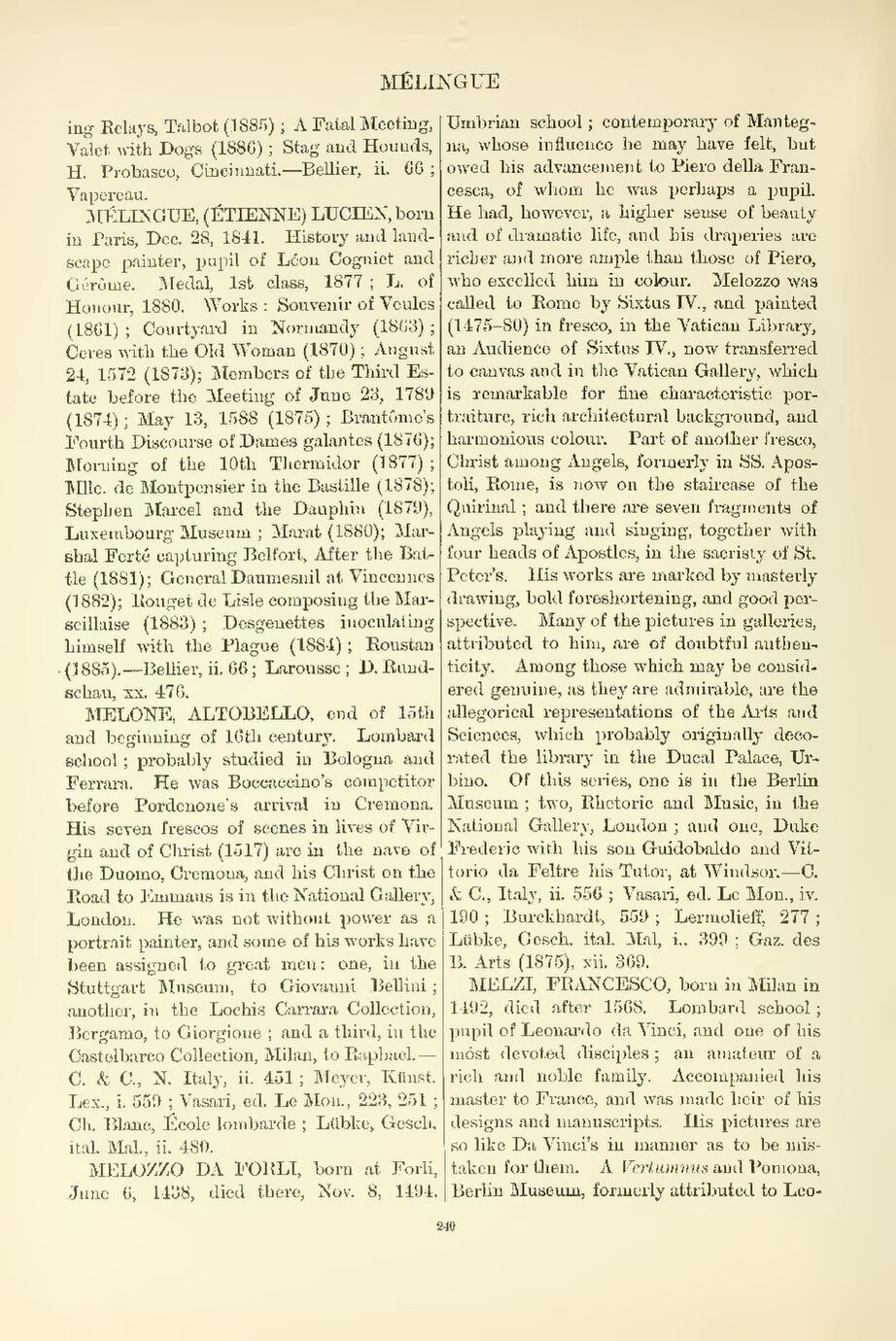- ing Relays, Talbot (1885); A Fatal Meeting,
Valet with Dogs (1886); Stag and Hounds, H. Probasco, Cincinnati.—Bellier, ii. 66; Vapereau.
MÉLINGUE, (ÉTIENNE) LUCIEN, born
in Paris, Dec. 28, 1841. History and landscape
painter, pupil of Léon Cogniet and
Gérôme. Medal, 1st class, 1877; L. of
Honour, 1880. Works: Souvenir of Veules
(1861); Courtyard in Normandy (1863);
Ceres with the Old Woman (1870); August
24, 1572 (1873); Members of the Third Estate
before the Meeting of June 23, 1789
(1874); May 13, 1588 (1875); Brantôme's
Fourth Discourse of Dames galantes (1876);
Morning of the 10th Thermidor (1877);
Mlle. de Montpensier in the Bastille (1878);
Stephen Marcel and the Dauphin (1879),
Luxembourg Museum; Marat (1880); Marshal
Ferté capturing Belfort, After the Battle
(1881); General Daumesnil at Vincennes
(1882); Rouget de Lisle composing the Marseillaise
(1883); Desgenettes inoculating
himself with the Plague (1884); Roustan
(1885).—Bellier, ii. 66; Larousse; D. Rundschau,
xx. 476.
MELONE, ALTOBELLO, end of 15th
and beginning of 16th century. Lombard
school; probably studied in Bologna and
Ferrara. He was Boccaccino's competitor
before Pordenone's arrival in Cremona.
His seven frescos of scenes in lives of Virgin
and of Christ (1517) are in the nave of
the Duomo, Cremona, and his Christ on the
Road to Emmaus is in the National Gallery,
London. He was not without power as a
portrait painter, and some of his works have
been assigned to great men: one, in the
Stuttgart Museum, to Giovanni Bellini;
another, in the Lochis Carrara Collection,
Bergamo, to Giorgione; and a third, in the
Castelbarco Collection, Milan, to Raphael.—C.
& C., N. Italy, ii. 451; Meyer, Künst.
Lex., i. 559; Vasari, ed. Le Mon., 223, 251;
Ch. Blanc, École lombarde; Lübke, Gesch.
ital. Mal., ii. 480.
MELOZZO DA FORLI, born at Forli,
June 6, 1438, died there, Nov. 8, 1494.
Umbrian school; contemporary of Mantegna,
whose influence he may have felt, but
owed his advancement to Piero della Francesca,
of whom he was perhaps a pupil.
He had, however, a higher sense of beauty
and of dramatic life, and his draperies are
richer and more ample than those of Piero,
who excelled him in colour. Melozzo was
called to Rome by Sixtus IV., and painted
(1475-80) in fresco, in the Vatican Library,
an Audience of Sixtus IV., now transferred
to canvas and in the Vatican Gallery, which
is remarkable for fine characteristic portraiture,
rich architectural background, and
harmonious colour. Part of another fresco,
Christ among Angels, formerly in SS. Apostoli,
Rome, is now on the staircase of the
Quirinal; and there are seven fragments of
Angels playing and singing, together with
four heads of Apostles, in the sacristy of St.
Peter's. His works are marked by masterly
drawing, bold foreshortening, and good perspective.
Many of the pictures in galleries,
attributed to him, are of doubtful authenticity.
Among those which may be considered
genuine, as they are admirable, are the
allegorical representations of the Arts and
Sciences, which probably originally decorated
the library in the Ducal Palace, Urbino.
Of this series, one is in the Berlin
Museum; two, Rhetoric and Music, in the
National Gallery, London; and one, Duke
Frederic with his son Guidobaldo and Vittorio
da Feltre his Tutor, at Windsor.—C.
& C., Italy, ii. 556; Vasari, ed. Le Mon., iv.
190; Burckhardt, 559; Lermolieff, 277;
Lübke, Gesch. ital. Mal, i.. 399; Gaz. des
B. Arts (1875), xii. 369.
MELZI, FRANCESCO, born in Milan in
1492, died after 1568. Lombard school;
pupil of Leonardo da Vinci, and one of his
most devoted disciples; an amateur of a
rich and noble family. Accompanied his
master to France, and was made heir of his
designs and manuscripts. His pictures are
so like Da Vinci's in manner as to be mistaken
for them. A Vertumnus and Pomona,
Berlin Museum, formerly attributed to Leo-
